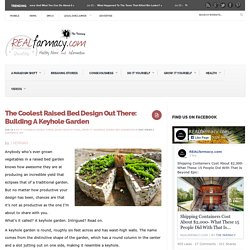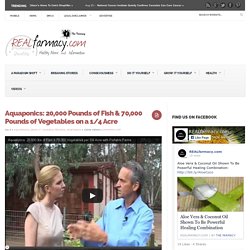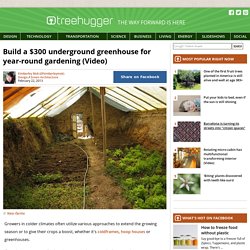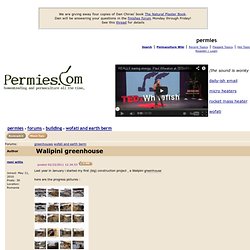

The Coolest Raised Bed Design Out There: Building A Keyhole GardenREALfarmacy.com. By J HERMAN Anybody who’s ever grown vegetables in a raised bed garden knows how awesome they are at producing an incredible yield that eclipses that of a traditional garden.

But no matter how productive your design has been, chances are that it’s not as productive as the one I’m about to share with you. What’s it called? A keyhole garden. Intrigued? A keyhole garden is round, roughly six feet across and has waist-high walls. As much as I’d love to say I came up with this method of raised-bed gardening, it is believed to have originated in areas of Africa in which communities had very poor soil and a long dry season and, as such, were seeking a means of growing fresh veggies as economically as they could. This method wins all around, providing a very high yield and cheap construction. The shape of the walls provides much more strength than traditional straight walls found in other raised bed gardens. As far as what you’d like to build the walls out of, that decision is yours to make.
40 Edible Plants That Will Grow in Partial Shade. By ALICIA BAYER We all know that most garden crops want as much sun as possible.

Tomatoes, melons and peppers will positively pout if they don’t get oodles of light. What you may not realize is that many other garden crops will do quite well with limited sunlight. Which plants will put up with lower light levels? A general rule is that plants grown for their stems, leaves or buds generally tolerate light shade fairly well. That said, even many of these crops will also tolerate light shade, simply providing smaller yields. The following crops will grow with as little as three to six hours of sun per day, or constant dappled shade. Keep in mind:-If trees or other plants are the source of shade, garden plants may not only have to compete for light but also nutrients and water. -The amount of shade may vary by the seasons when the angle of the sun is different. Start a 1-Acre, Self-Sufficient Homestead - Modern Homesteading. Related Content Always Have a Backup Plan The journey to a self-sufficient life is a bumpy ride.

Having a backup plan — or two — can make all ... Everyone will have a different approach to keeping a self-sufficient homestead, and it’s unlikely that any two 1-acre farms will follow the same plan or methods or agree completely on how to homestead. Some people like cows; other people are afraid of them. For myself, on a 1-acre farm of good, well-drained land, I would keep a cow and a goat, a few pigs and maybe a dozen hens.
Raising a Dairy Cow Cow or no cow? On the other hand, the food that you buy in for this family cow will cost you hundreds of dollars each year. 1-Acre Farm With a Family Cow Half of your land would be put down to grass, leaving half an acre arable (not allowing for the land on which the house and other buildings stand). Grazing Management At the first sign the grass patch is suffering from overgrazing, take the cow away. How to plan your garden to feed your family! Aquaponics: 20,000 Pounds of Fish & 70,000 Pounds of Vegetables on a 1/4 Acre. Aquaponics is the combination of aquaculture (fish farming) and hydroponics (growing plants in water only), in a carefully designed, hyper-productive closed-loop system.

There is no pesticide, no fungicide, no fertilizer, no watering the garden, no bending down to weed the garden, and you produce food year round, no matter the climate or soil conditions. This can work in the Sahara Desert or in Antarctica. Using this system, each 25 SF of grow space can feed one adult 25% of their protein and all of their table vegetables, year round, forever! On-site local food production is the ultimate form of food storage. Image: Wikimedia Commons. TreeHugger. Growers in colder climates often utilize various approaches to extend the growing season or to give their crops a boost, whether it's coldframes, hoop houses or greenhouses.

Greenhouses are usually glazed structures, but are typically expensive to construct and heat throughout the winter. A much more affordable and effective alternative to glass greenhouses is the walipini (an Aymara Indian word for a "place of warmth"), also known as an underground or pit greenhouse. Walipini greenhouse (wofati and earth berm forum at permies) @K9 I didn't come back and answer your question: "So what should the pitch angle be then?

" Bottom line: if your system is working then good for you, this is simply an attempt to explain the methodology I would have used so that a) I can be corrected if I am wrong and b) if I am correct then others can use it for their projects. Long post, but I hope it is useful for someone..... The purpose is to have the glass at right angles to the sun’s rays at the time that is most useful to you - right angles ensures maximum penetration of the energy. Given that the purpose of the Walapini is to act as a greenhouse it is probable that the optimal time is in the spring and fall. Furthermore, setting the angle based on the highest angle of the sun on any given day at that time doesn’t make sense – better to optimize it for, say, 2 hours either side of that so the optimal position is hit twice. Sustainable By Design. Latitude & Longitude, Find your latitude & longitude coordinates.